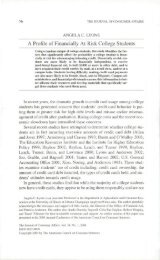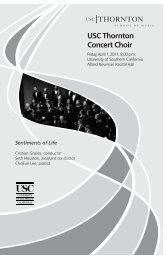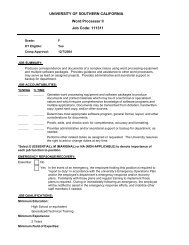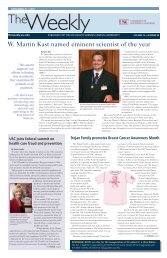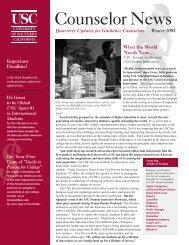Enrollment Management, Inc. - University of Southern California
Enrollment Management, Inc. - University of Southern California
Enrollment Management, Inc. - University of Southern California
You also want an ePaper? Increase the reach of your titles
YUMPU automatically turns print PDFs into web optimized ePapers that Google loves.
<strong>Enrollment</strong> <strong>Management</strong>, <strong>Inc</strong>.:<br />
External Influences on Our Practice<br />
Scott Andrew Schulz, <strong>University</strong> <strong>of</strong> <strong>Southern</strong> <strong>California</strong> (sschulz@usc.edu)<br />
Jerome A. Lucido, <strong>University</strong> <strong>of</strong> <strong>Southern</strong> <strong>California</strong> (jlucido@usc.edu)<br />
USC Center for <strong>Enrollment</strong> Research, Policy, and Practice<br />
January 2011<br />
Schulz & Lucido 1
USC Center for <strong>Enrollment</strong> Research, Policy, and Practice<br />
The USC Center for <strong>Enrollment</strong> Research, Policy, and Practice was founded<br />
in 2007 and is dedicated to research and action that advances the societal<br />
benefit <strong>of</strong> enrollment policies and practices in higher education. In 2010,<br />
the center became part <strong>of</strong> the USC Rossier School <strong>of</strong> Education, one <strong>of</strong><br />
the world’s premier schools committed to strengthening society through<br />
excellence in education.
Are the educational values and goals <strong>of</strong> admission and enrollment <strong>of</strong>ficers undermined by their processes and<br />
practices? This important question was posed by Andrew Delbanco <strong>of</strong> Columbia <strong>University</strong> during an address at<br />
the College Board Colloquium in January 2002. At the heart <strong>of</strong> his concern was the sense that institutional pursuits<br />
<strong>of</strong> status and prestige in the face <strong>of</strong> market competition are leading enrollment pr<strong>of</strong>essionals to neglect their moral<br />
commitments to students. Delbanco argued that these market forces are <strong>of</strong>ten at odds with collective efforts to<br />
promote student access and opportunity through such mechanisms as early decision programs to boost application<br />
rates and preferential aid packaging that tend to disproportionately benefit wealthier students. Delbanco challenged<br />
his audience to take a more insightful look at their practices and weigh the costs and benefits <strong>of</strong> the admissions and<br />
financial aid system.<br />
“It is apparent many enrollment<br />
practices have become more<br />
market-driven, <strong>of</strong>tentimes aiming<br />
to secure students who not only fill<br />
seats but fulfill myriad institutional<br />
goals, predominantly those with<br />
prestige and revenue implications.”<br />
Years later, Delbanco’s concerns about the trajectory <strong>of</strong> the enrollment<br />
sector appear to have gone unheeded. It is apparent many enrollment<br />
practices have become more market-driven, <strong>of</strong>tentimes aiming to secure<br />
students who not only fill seats but fulfill myriad institutional goals,<br />
predominantly those with prestige and revenue implications. That said,<br />
the reasons behind this market orientation have been less clear.<br />
A brief look at the history <strong>of</strong> enrollment management reminds us that<br />
colleges and universities have not always been comprised <strong>of</strong> enrollment<br />
units with complex and sometimes competing interests. Until the late<br />
nineteenth century, admissions, student aid and other enrollment-related<br />
functions were largely under the purview <strong>of</strong> faculty and senior institutional leaders at the relatively small number<br />
<strong>of</strong> institutions in the United States (Coomes, 2000). However, with the establishment <strong>of</strong> land-grant institutions as<br />
a function <strong>of</strong> the Morrill Acts <strong>of</strong> 1862 and 1890, and increased emphasis on education at federal and state levels,<br />
Americans increasingly saw a college education as a worthy and attainable goal (Thelin, 2003). Colleges and<br />
universities found themselves in need <strong>of</strong> more formalized administrative structures to manage rising enrollments.<br />
As such, the registrar role was developed and to a large extent broadly coordinated all non-academic related tasks,<br />
including student recruitment, financial aid, recordkeeping, and student service areas (Conner 1979). As the<br />
twentieth century unfolded, the registrar’s role was gradually unbundled, giving way to more specialized roles<br />
within the greater enrollment function. Private institutions began utilizing admission directors to recruit prospective<br />
1 Though Andrew Delbanco specifically referred to admission and student aid pr<strong>of</strong>essionals in his address, consistent with our larger research agenda, we prefer to include admission and student<br />
aid pr<strong>of</strong>essionals within a broader category, “enrollment pr<strong>of</strong>essionals,” that includes any institutional member that has a specific and dedicated role in the overall process <strong>of</strong> recruiting, enrolling,<br />
retaining and graduating students<br />
Schulz & Lucido 2
Schulz & Lucido 3<br />
students at the turn <strong>of</strong> the century (Henderson, 2008) and admission <strong>of</strong>ficers, financial aid directors, student<br />
services <strong>of</strong>ficers and the like became increasingly common so as to manage an influx <strong>of</strong> students and their many<br />
needs following World War II and to strategically coordinate efforts to fill seats during leaner years once the<br />
“tidal wave” had subsided in the mid-twentieth century (Hossler & Anderson, 2004; Huddleston, 2000;<br />
Coomes, 2000; Duffy & Goldberg, 1998).<br />
Concurrently, various pr<strong>of</strong>essional organizations emerged for these groups <strong>of</strong> enrollment pr<strong>of</strong>essionals, including<br />
the American Association <strong>of</strong> Collegiate Registrars in 1910 (later becoming the American Association <strong>of</strong> Collegiate<br />
Registrars and Admissions Officers), the National Association for College Admission Counseling (NACAC) in<br />
1937, the National Association for Student Personnel Administrators (NASPA) in 1951, the National Association<br />
<strong>of</strong> Student Financial Aid Administrators (NASFAA) in 1966, and the Association for Institutional Research (AIR)<br />
in 1966. Though they may have had slightly different missions, these governing associations and the pr<strong>of</strong>essionals<br />
they represent generally made commitments to serving students and helping to ensure that all students have<br />
opportunities to fulfill their educational potential, lead productive lives, and make valuable contributions as<br />
engaged members <strong>of</strong> society.<br />
In 1972, the federal government passed legislation that essentially gave birth to the enrollment management<br />
pr<strong>of</strong>ession, providing the stimulus necessary to bring together the aforementioned groups <strong>of</strong> educational<br />
pr<strong>of</strong>essionals under a common umbrella. During the reauthorization <strong>of</strong> the Higher Education Act, aid that had<br />
previously been given directly to institutions for distribution to students was shifted directly to students in an<br />
effort to give students more buying power and infuse the higher education system with market-like competition<br />
predicated on capitalist ideals (Slaughter & Leslie, 2001). Colleges and universities now had to compete for<br />
students and their aid dollars.<br />
Sensing a need for institutions to tactically bring together various personnel with direct responsibility for the<br />
recruitment, enrollment, retention, and graduation <strong>of</strong> students, the “enrollment management” concept was coined<br />
by Jack Maguire and Frank Campanella at Boston College shortly thereafter in 1974 (Henderson, 2008).<br />
A comprehensive enrollment unit may include institutional research and planning, marketing, admissions,<br />
registrar, financial aid, student orientation, retention, and advising units (Huddleston, 2000). Though enrollment<br />
management partially evolved out <strong>of</strong> the recognition that institutions needed more strategic, coordinated<br />
approaches to meeting multi-faceted challenges that impacted institutional enrollments and destabilized resources,
especially in the wake <strong>of</strong> increasing competition for students,<br />
the heart <strong>of</strong> the enrollment management concept was also<br />
founded upon an educational mission. By more effectively<br />
planning, implementing, and evaluating functions critical to<br />
moving students through the enrollment pipeline from the point<br />
<strong>of</strong> initial contact to graduation, institutions can use enrollment<br />
management practices to enhance the efficacy by which they<br />
meet their educational commitments to students (Penn, 1999).<br />
For example, institutions can enroll more demographically<br />
diverse classes <strong>of</strong> students so as to provide students with the<br />
educational benefits <strong>of</strong> a more diverse environment, maximize<br />
course availability, and consistently monitor and meet student<br />
financial needs, thereby increasing the chances <strong>of</strong> student<br />
success. Simultaneously, careful preparation, research, and coordination <strong>of</strong> units allow institutions to enroll a mix <strong>of</strong><br />
students that meet institutional revenue, diversity, academic, and social goals. In effect, enrollment management<br />
is a more holistic, interdependent campus-wide approach to managing enrollments that took shape as institutions<br />
sought to more comprehensively improve student educational experiences and outcomes while concurrently meeting<br />
various institutional needs and institutional goals.<br />
At some point, however, the practice <strong>of</strong> enrollment management arguably morphed from a strategic effort grounded<br />
in educational ideals into one obsessed with serving institutional interests. Competition for students and their<br />
aid dollars gradually led to a plethora <strong>of</strong> market-driven practices, many <strong>of</strong> which are not in the best interests <strong>of</strong><br />
students. Assessing an institution’s institutional quality is arguably difficult. Rather than compete for students based<br />
on educational quality or the extent to which institutions were effectively meeting their stated missions, usually<br />
oriented toward public service and equitable opportunity, colleges and universities competed by developing a<br />
variety <strong>of</strong> strategies with prestige and revenue concerns at the forefront. More specifically, colleges and universities<br />
competed with one another by becoming more selective (Breland, Maxey, Gernand, Cumming, & Trapani, 2002), by<br />
segmenting recruitment markets based on student demographic variables that include socioeconomic status (Black,<br />
2009; Schulz, 2008), by increasingly utilizing merit-based aid programs to entice students (Heller, 2006; McPherson<br />
Schulz & Lucido 4
Rather than compete for students<br />
based on educational quality or the<br />
extent to which institutions were<br />
effectively meeting their stated<br />
missions, usually oriented toward<br />
public service and equitable<br />
opportunity, colleges and universities<br />
competed by developing a variety<br />
<strong>of</strong> strategies with prestige and<br />
revenue concerns at the forefront.<br />
Schulz & Lucido 5<br />
& Schapiro, 1998) despite adverse impacts upon low-income and minority<br />
students (Griffith, 2009), by developing early decision admissions<br />
programs to increase yield rates and enhance institutional pr<strong>of</strong>iles<br />
(Fallows, 2001) despite their propensity to advantage more affluent<br />
students (Toor, 2001), and by marketing consumables such as student<br />
recreation facilities to capitalize on the consumer mentality <strong>of</strong> potential<br />
students (Schulz, 2008). A market discourse took hold that fundamentally<br />
reoriented the way institutions viewed students. Consistent with the<br />
tenets <strong>of</strong> academic capitalism, students became consumers seeking an<br />
educational product, and enrollment managers sought to ensure they<br />
<strong>of</strong>fered the best product as a function <strong>of</strong> institutional exclusivity and<br />
the types <strong>of</strong> students enrolled (Slaughter and Leslie, 2001). Nearly forty<br />
years after the reauthorization <strong>of</strong> the Higher Education Act directed<br />
aid from institutions to students in an effort to enhance student choice and opportunity, the system <strong>of</strong> higher<br />
education continues to be widely stratified with regard to college degree attainment across family income levels<br />
(Mortensen, 2000) and with regard to the distribution <strong>of</strong> students within America’s educational hierarchy<br />
(Astin & Oseguera, 2004). A market-driven enrollment industry has emerged with priorities that are eroding<br />
the educational foundation <strong>of</strong> the academy and hindering our capacity to meet President Obama’s goal <strong>of</strong><br />
having the United States reclaim its position as the world leader in educational attainment by the year 2020.<br />
This has to change.<br />
Before changes can be made, however, one must first understand why enrollment management has transformed<br />
into a market-driven enterprise. Next, one must better understand the pr<strong>of</strong>ession and, specific to this analysis,<br />
external influences on its practice. In particular, it is critical to assess:<br />
• Where do enrollment pr<strong>of</strong>essionals derive their strategies and for what purpose<br />
in general?<br />
• What types <strong>of</strong> strategies have enrollment pr<strong>of</strong>essionals utilized from these sources?<br />
• What is their motivation for turning to these strategy sources?<br />
• How did enrollment pr<strong>of</strong>essionals establish relationships with these entities?<br />
• What are the anticipated long-term impacts <strong>of</strong> these trends?
In an effort to address these and other issues related to enrollment pr<strong>of</strong>essionals, we conducted over 50 semi-struc-<br />
tured interviews <strong>of</strong> one hour each with chief admission <strong>of</strong>ficers and chief enrollment <strong>of</strong>ficers during early 2009.<br />
These enrollment pr<strong>of</strong>essionals primarily served at four-year institutions that are diverse with respect to public-<br />
private designation, Carnegie classification, and geographic location. Perspectives from enrollment pr<strong>of</strong>essionals<br />
at 50 unique institutions are represented in this analysis.<br />
Strategy Sources and Recommendations<br />
When asked where enrollment pr<strong>of</strong>essionals seek to inform and borrow strategy ideas to guide their practice,<br />
chief admission and chief enrollment <strong>of</strong>ficers primarily highlighted two distinct areas: business resources and<br />
pr<strong>of</strong>essional consultants, with substantially heavier reliance on consultants for direction. For the sake <strong>of</strong> this<br />
analysis, we will focus almost exclusively on consultants as strategy sources, though we would briefly like to note<br />
the considerable reliance on business resources as well.<br />
Approximately one-third <strong>of</strong> participants reported utilizing business<br />
resources. <strong>Enrollment</strong> pr<strong>of</strong>essionals identified business periodicals such<br />
as the Stanford Social Innovation Review, Fast Company, Harvard<br />
Business Review, The Economist and Forbes as useful for their practice,<br />
along with printed and online resources that outline general technology<br />
and communication trends, management, and customer service<br />
developments. Marketing periodicals such as Advertising Age,<br />
MarketingSherpa, and The Marketing News, provided by the American<br />
Marketing Association, were additional sources specified from which<br />
enrollment pr<strong>of</strong>essionals extract strategy ideas. A handful <strong>of</strong> enrollment<br />
pr<strong>of</strong>essionals made a point <strong>of</strong> stating that they hold business resources<br />
in high regard, viewing the corporate sector as ahead <strong>of</strong> the curve as<br />
In essence, evidence suggests<br />
that ideas and strategies commonly<br />
exchanged within the business sphere<br />
influence enrollment policy and<br />
practice as enrollment pr<strong>of</strong>essionals<br />
draw upon business resources<br />
to inform their work within colleges<br />
and universities.<br />
compared to resources from pr<strong>of</strong>essional associations and other non-corporate sources. Others praised the corporate<br />
sector for what they believed to be its proven efficiency and effectiveness, which encourages enrollment pr<strong>of</strong>es-<br />
sionals to place their trust in corporate strategies and support efforts to transplant them into the higher education<br />
sector. In essence, evidence suggests that ideas and strategies commonly exchanged within the business sphere<br />
influence enrollment policy and practice as enrollment pr<strong>of</strong>essionals draw upon business resources to inform their<br />
2 For the sake <strong>of</strong> this analysis, the term consultant will be used to collectively refer to all educational vendors and consultants that sell a product or service. They may be for-pr<strong>of</strong>it or non-pr<strong>of</strong>it entities.<br />
Schulz & Lucido 6
Schulz & Lucido 7<br />
work within colleges and universities. Consid-<br />
ering the fact that such resources are designed<br />
to help enhance the bottom line for businesses,<br />
concerns about the extent to which they may<br />
encourage or facilitate a move to the market in<br />
pursuit <strong>of</strong> prestige and revenue, to the detri-<br />
ment <strong>of</strong> an institution’s educational function,<br />
are legitimate.<br />
Though business resources may be an<br />
important external influence on the practice<br />
<strong>of</strong> enrollment management, they pale in<br />
comparison to the relative influence <strong>of</strong><br />
consultants. Of the 50 unique institutions<br />
represented in our study, enrollment<br />
pr<strong>of</strong>essionals at all but three mentioned having<br />
either hired or sought ideas from consultants,<br />
with most institutions having current or recent contracts with one or more external consultants. To best communi-<br />
cate the widespread use <strong>of</strong> consultants, it would seem appropriate to provide the substantial list <strong>of</strong> consultants that<br />
were specifically identified by the relatively small number <strong>of</strong> enrollment pr<strong>of</strong>essionals with whom we spoke.<br />
Consultant strategy sources included the following entities, in no particular order:<br />
TargetX Hobson’s<br />
George Dane<br />
College Marketing<br />
Technologies Steve Brooks<br />
Noel-Levitz Associates Eduventures James Towers<br />
Royall & Company EMAS Pro Datatel Caludis<br />
Lawler Group Fire Engine RED ACT, <strong>Inc</strong>.<br />
AACRAO<br />
Consulting<br />
North Charles<br />
Richard Harrison<br />
Street Design Allied Marketing Bailey/The Agency NRCCUA<br />
Pro Ed TALISMA Peterson’s<br />
Ruffalo Cody Human Capital Princeton Review<br />
College Board Student<br />
Stamats Hyland OnBase<br />
Carnegie<br />
Search Service<br />
Scannell & Kurz<br />
Kelsh Wilson<br />
Communications Hardwick Day<br />
Design The Creativist Maguire Associates
Though some are more specific than others and some overlap may be evident, areas <strong>of</strong> focus for which ideas were<br />
harvested or services rendered included the following, again in no particular order:<br />
Purchasing names to<br />
generate prospects<br />
While a few <strong>of</strong> the services identified represent non-pr<strong>of</strong>it entities, these lists are quite extensive and reflect a<br />
booming higher education industry. Private-equity firms invested $161 million dollars into private companies<br />
that run for-pr<strong>of</strong>it institutions and educational firms in 2005 (Blumenstyk, 2005). Not only has the level <strong>of</strong> those<br />
investments since increased, but more colleges than ever are hiring outside companies to help them find and enroll<br />
students (Blumenstyk, 2007).<br />
<strong>Enrollment</strong><br />
processes and<br />
procedures E-mail campaigning Website Visibility<br />
Marketing<br />
Campus visit<br />
Mailings<br />
strategies Social networking Publishing<br />
Data capturing and<br />
cleaning in<br />
experience<br />
database<br />
Constituent<br />
Calendar scheduling management Relationship<br />
Financial aid modeling Viewbook system<br />
system<br />
<strong>Management</strong> (CRM)<br />
Financial aid<br />
Telecounseling Communication with Geodemographic discounting matrix<br />
Branding<br />
program families<br />
work<br />
policy<br />
Academic<br />
competitiveness <strong>of</strong><br />
Aid strategies Messaging File analysis process Online community high schools<br />
Reorganizations to<br />
Scholarship Efforts to convert <strong>Enrollment</strong> student financial<br />
S<strong>of</strong>tware oversight funding inquiries to applicants strategies service sector<br />
Electronic/online Communication<br />
Admissions<br />
applications<br />
efforts Promotion Telemarketing records/imaging<br />
Aid packaging and<br />
Direct mail and<br />
leveraging Data analysis Predictive modeling direct marketing Online advising<br />
<strong>Enrollment</strong> revenue<br />
Strategic<br />
management<br />
marketing system/net revenue<br />
Search programs<br />
initiative<br />
projections<br />
Access to/Monitor other<br />
institutional<br />
strategies/approaches<br />
To be clear, there is nothing inherently troubling about institutions seeking assistance from external sources to<br />
help them recruit, enroll, and meet student needs. In fact, some <strong>of</strong> the consultants identified have a history <strong>of</strong><br />
service to underserved populations and to state and national educational goals. What is troubling is the market<br />
orientation <strong>of</strong> many <strong>of</strong> the strategies enrollment pr<strong>of</strong>essionals are borrowing from the private sector and infusing<br />
within colleges and universities. Upon closer examination <strong>of</strong> our data, strategies implemented by enrollment<br />
pr<strong>of</strong>essionals based on consultant recommendations largely center on institutional marketing and branding,<br />
tudent search, and the strategic use <strong>of</strong> financial aid rather than on improving the educational practices <strong>of</strong><br />
institutions to attract and secure students.<br />
Student tracking Student Information<br />
tool<br />
Systems<br />
Fundraising<br />
model for<br />
enrollment and<br />
territory mgmt Retention outreach<br />
Financial aid<br />
research<br />
Survey research on<br />
students and parents<br />
Schulz & Lucido 8
Upon closer examination <strong>of</strong> our data,<br />
strategies implemented by enrollment<br />
pr<strong>of</strong>essionals based on consultant<br />
recommendations largely center on<br />
institutional marketing and branding,<br />
student search, and the strategic use <strong>of</strong><br />
financial aid rather than on improving<br />
the educational practices <strong>of</strong> institutions<br />
to attract and secure students.<br />
Schulz & Lucido 9<br />
Regardless <strong>of</strong> whether consultants are actually pushing enrollment<br />
pr<strong>of</strong>essionals to adopt market-driven practices or consultants are simply<br />
responding to the desires <strong>of</strong> their clients, consultants appear to be<br />
responsible for perpetuating an enrollment system governed by<br />
competition and revenue concerns. <strong>Enrollment</strong> pr<strong>of</strong>essionals we spoke<br />
with described having implemented strategies from consultants that<br />
encourage substantial investments in communication and marketing areas<br />
for the purpose <strong>of</strong> student persuasion. More than half <strong>of</strong> the enrollment<br />
pr<strong>of</strong>essionals in our study looked to external consultants to enhance their<br />
marketing efforts, embracing everything from variable piece marketing to<br />
mass notification strategies, customized websites, high-end publications,<br />
and the integration <strong>of</strong> e-mail, blogging, and social network applications to influence student behavior. Moreover,<br />
one-third <strong>of</strong> enrollment pr<strong>of</strong>essionals within our study reportedly turned to consultants for assistance with student<br />
search processes, sometimes highlighting how consultant strategies allowed enrollment pr<strong>of</strong>essionals to target and<br />
segment recruitment efforts into “proven” markets. Rather than expand opportunity, search efforts became more<br />
focused as consultants helped enrollment pr<strong>of</strong>essionals shift “from fishing with a net to fishing with a spear,” by<br />
specifying “which students [the institution] need to be in conversation with.” Finally, strategies from consultants<br />
have facilitated efforts to use financial aid as a weapon for competitive advantage rather than primarily as a tool for<br />
assisting students. This last piece in particular especially deserves scrutiny.
America’s financial aid system is historically built on the notion it is socially responsible to use merit-aid to<br />
encourage promising students to maximize educational opportunities and to use need-based aid to ensure that the<br />
talents <strong>of</strong> the less advantaged are cultivated for the greater social good (McPherson & Schapiro, 1998). That said,<br />
our conversations with enrollment pr<strong>of</strong>essionals suggest they are being led to redefine the purpose <strong>of</strong> student aid<br />
as one predicated on institutional need. More<br />
than one-third <strong>of</strong> the institutions represented<br />
in our sample have reportedly turned to<br />
external consultants for assistance with financial<br />
aid modeling, leveraging, packaging, research<br />
and/or analysis. <strong>Enrollment</strong> pr<strong>of</strong>essionals from<br />
a handful <strong>of</strong> these institutions provided specific<br />
examples <strong>of</strong> how consultants have influenced<br />
their practice. In addition to embracing the use <strong>of</strong><br />
econometric modeling as a means for strategically<br />
estimating the effect <strong>of</strong> student aid on yield behavior,<br />
enrollment pr<strong>of</strong>essionals described having shaped their aid packaging in response to the recommendation <strong>of</strong><br />
consultants. More specifically, we were presented with<br />
examples whereby enrollment pr<strong>of</strong>essionals gave less money<br />
to more students in an effort to more efficiently utilize<br />
limited aid resources en route to securing enrollments.<br />
In one account, full tuition awards were broken into smaller<br />
grants for students after consultants suggested those same<br />
students would still enroll, a strategy that may result in more<br />
students with unmet need. Yet another enrollment pr<strong>of</strong>es-<br />
sional was persuaded to front load financial aid awards to<br />
increase the admissions yield for new freshmen students,<br />
a practice used to entice students to enroll but one that also<br />
leaves them to scramble for funding in subsequent years.<br />
At its core, these practices reveal how external influences<br />
Schulz & Lucido 10
Schulz & Lucido 11<br />
may be fostering a fundamental rethinking as to the purpose <strong>of</strong> financial aid and the overall function <strong>of</strong> enrollment<br />
management. Lines are being blurred between a corporate sector, whose values are founded upon notions <strong>of</strong> com-<br />
petition and revenue maximization, and an educational sector traditionally motivated by social considerations.<br />
Why <strong>Enrollment</strong> Pr<strong>of</strong>essionals Utilize Consultants<br />
If strategies from consultants are problematic or questionable, why do enrollment pr<strong>of</strong>essionals turn to consultants<br />
as strategy sources? We must consider their motivations as well as how enrollment pr<strong>of</strong>essionals come into contact<br />
with consultants, which harbor both proactive and reactive elements. This section will first more closely analyze<br />
their impetus to reach out to consultants. Interestingly, enrollment pr<strong>of</strong>essionals not only cited reasons behind<br />
mining commercial groups for strategies but highlighted ways external consultants are employed as strategies as<br />
well. The following analysis will more specifically speak to these themes, identifying how the need for expertise,<br />
political expediency, a capacity for monitoring competitors, and pr<strong>of</strong>essional histories with consultants lead<br />
enrollment pr<strong>of</strong>essionals to engage the commercial higher education sector.<br />
Expertise<br />
One <strong>of</strong> the most prominent themes to emerge from our analysis is that <strong>of</strong> the desire for expertise in enrollment<br />
management. <strong>Enrollment</strong> pr<strong>of</strong>essionals from nearly half <strong>of</strong> the institutions represented in our study highlighted<br />
the need for content experts and proven strategies, especially in the face <strong>of</strong> tight institutional budgets and<br />
personnel resources that are constrained when it comes to their size, availability, and know-how.<br />
I think you just have to be realistic with how you spend your budget dollars, and I just think there’s certain projects<br />
that it makes more sense to go to an expert right away and say, “Hey, you do this and we will -” instead <strong>of</strong> us spinning<br />
our wheels and not producing a quality product.<br />
Well, with Noel-Levitz, in terms <strong>of</strong> the [financial aid] leveraging, and we just don’t have the statistical know-how to do<br />
things they can do. We don’t have anybody on staff that has the time or the expertise to crunch the numbers like they do….]<br />
We’re very committed to a leveraging approach, and they just have the expertise…With TargetX, we initially got in with<br />
them on their email piece. They can just do things that we don’t have the technical capability to do.<br />
I think just knowing that they’ve got expertise and the time to work on projects and give us the knowledge that we<br />
really don’t have the time to do. We hire the calling folks because they can reach 15,000 to 20,000 students in three<br />
weeks, and there’s no way we could pull that <strong>of</strong>f. In terms <strong>of</strong> the financial aid leveraging and some <strong>of</strong> the market<br />
development, they’ve got the data, they’ve got the analyses that it would take us forever to come up with. So I do<br />
think that we’re paying for the brain power behind these different things.<br />
Most enrollment <strong>of</strong>fices, we don’t have the technology to be doing this in-house, and it’s so incredibly fine-tuned.<br />
Actually, although we’ve spent more money, it has saved us over $250,000 already in mailing costs, publications,
eliminating large portions <strong>of</strong> mailings, eliminating lines <strong>of</strong> work, not having to rehire someone.<br />
We don’t have the staff to do the email blasts, to do the text messaging. Everything like this sounds pretty simple,<br />
but it takes us a lot longer to do it than it does an outside source.<br />
It’s cheap. It doesn’t take any human resources either. And there’s a lot more flexibility, I feel, when working with<br />
third-party vendors on stuff that they’re experts at rather than try and recreate it here within a strained kind <strong>of</strong> IT<br />
department. It’s always busy and stuff like that.<br />
External consultants are viewed as authorities on enrollment matters, in part due to the scale <strong>of</strong> their operations<br />
that <strong>of</strong>ten allows them to test and refine ideas among their many constituents.<br />
Well, our search program and application generation program, which we work with them on I think probably gets<br />
changed every year. Because they work with about 150 schools, we’re able to get some really nice, direct examples <strong>of</strong> things<br />
that are kind <strong>of</strong> tried and tested and true in terms <strong>of</strong> at other places and we’re able to change them here. So every year that<br />
we do our search or we do our application generation program we’re changing things up a little bit.<br />
Some enrollment pr<strong>of</strong>essionals we spoke with placed so much trust in the expertise <strong>of</strong> consultants that they<br />
reportedly turn to them for advice and to affirm their approach to various issues regardless <strong>of</strong> whether a contract<br />
for services is in place. Their ideas are held in such high-esteem that enrollment pr<strong>of</strong>essionals make every effort<br />
to replicate them.<br />
But they are people that, even if I wasn’t doing business with them, I would call on for advice, for this, that or the<br />
other thing.<br />
I went to them to help make sure I was doing it the right way.<br />
…sometimes you do get ideas from vendors that, even if you don’t ultimately use the vendor, you’re able to implement<br />
some <strong>of</strong> it in-house.<br />
In essence, consultants are viewed as “innovative” and capable <strong>of</strong> taking institutions to “that next level” with their<br />
expertise that is not only viewed as desirable but crucial within a competitive market. The expertise <strong>of</strong> consultants<br />
is made all the more salient by enrollment pr<strong>of</strong>essionals trying to do more with fewer resources and an expertise<br />
deficiency within institutions. This last piece, in particular, may speak to serious issues within the development<br />
pipeline for enrollment pr<strong>of</strong>essionals; more specifically, revealing what may be inadequate preparation programs<br />
and a shortage <strong>of</strong> enrollment pr<strong>of</strong>essionals available to meet the needs <strong>of</strong> institutions.<br />
Political Expediency<br />
In addition to bringing in consultants to comprehensively assess enrollment policies and practices and to inform or<br />
carry out strategic initiatives, approximately one-fifth <strong>of</strong> the enrollment pr<strong>of</strong>essionals within our study stressed the<br />
Schulz & Lucido 12
Schulz & Lucido 13<br />
importance <strong>of</strong> hiring external consultants for reasons <strong>of</strong> political expediency. More simply put, it is easier to<br />
influence and reassure institutional authorities, including presidents, provosts, faculty and board members, that<br />
one’s enrollment policies and practices are sound by inviting the seemingly objective perspectives <strong>of</strong> external<br />
consultants than it is to preach from one’s own pulpit. As such, internal institutional politics may motivate<br />
enrollment pr<strong>of</strong>essionals to embrace consultants as<br />
strategy sources.<br />
Sometimes you want to convince your president or your provost to<br />
do something, but coming from you it doesn’t carry the same weight<br />
as if it comes from someone else outside the university who has done<br />
the research and reports the result. And that’s where we are. There<br />
is something I want to get done, and I’m going to ask someone to do<br />
the work and then report to the president.<br />
But I think the big piece with the consultants is hopefully removing<br />
some <strong>of</strong> the political pressures that come along with recommendations<br />
for change.<br />
That said, in some circumstances internal institutional<br />
politics may also encourage enrollment pr<strong>of</strong>essionals to<br />
utilize external consultants as a strategy in and <strong>of</strong> itself.<br />
<strong>Enrollment</strong> pr<strong>of</strong>essionals we spoke with described<br />
needing to bring in consultants to push through their<br />
agendas. Rather than reach out to commercial entities to<br />
conduct research and chart a course for change, a handful<br />
<strong>of</strong> enrollment pr<strong>of</strong>essionals detailed the practice <strong>of</strong> using consultants to state what is already known for reasons<br />
<strong>of</strong> political convenience.<br />
Well, <strong>of</strong> course, the external view <strong>of</strong> things always has value. Sometimes you have external people tell you what you already<br />
know so that you can say that people outside see this, because you can’t be a prophet in your own country.<br />
…I think you can’t be an expert in your own backyard. And if somebody comes in from 100 miles away and they say the same<br />
thing you’ve been saying, sometimes people listen better.<br />
And so sometimes you bring the consultants in to satisfy the board, to satisfy somebody outside, to verify that what you’re doing<br />
is, in fact, a good thing.<br />
In summary, there is evidence that suggests enrollment pr<strong>of</strong>essionals may channel limited funds to external<br />
consultants in an effort to avoid political barriers within their institutions. Aside from the consequences <strong>of</strong> inviting
consultants to introduce strategies disproportionately shaped by notions <strong>of</strong> competition and revenue maximization,<br />
this practice may also be inefficiently channeling limited resources to commercial agencies with few tangible<br />
gains for institutions and the students they serve.<br />
A Capacity for Monitoring Competitors<br />
A handful <strong>of</strong> enrollment pr<strong>of</strong>essionals we spoke with mentioned the need or desire to monitor their competitors as<br />
a reason they felt connecting with external consultants is important. The following two quotes serve to illustrate<br />
this perspective:<br />
And think that’s – sometimes utilizing our outside consultants to get a feel for what some <strong>of</strong> the other schools are doing sometimes,<br />
is helpful too. They’ll talk about, “You know, well, [institution] is moving towards [program] and they’re going to be<br />
implementing there a new first-year student program to help students pick majors. And so this product was going to be -.”<br />
And I’m like, “Oh really?” You hear little tidbits and then you have to research it a little bit more. I think sometimes they spill<br />
the beans without realizing that they are, and it helps you identify what somebody else is going to be doing or what they’re<br />
working on.<br />
The second thing – and this is probably the more compelling thing, at least pr<strong>of</strong>essionally, and which will be no surprise to you<br />
– is that I know [my institution]. I know [my institution] better than any admissions person in the country, but I don’t know<br />
squat about a whole bunch <strong>of</strong> other schools and [consultants] do. They know a lot – they know a little about a lot <strong>of</strong> schools.<br />
And I don’t know anything about [an example institution], but if they’ve done consulting there, and they’re consulting here,<br />
then I’m going to know something about [that example institution] before the [consultant] leaves.<br />
Although only a small number referenced the monitoring <strong>of</strong> their competitors as reason for connecting with<br />
external consultants, the significance <strong>of</strong> this theme is worthy <strong>of</strong> inclusion for several reasons. First, it speaks to<br />
the competitive landscape that is redefining the purpose <strong>of</strong> enrollment management in higher education as one<br />
predicated on trumping other institutions rather than focusing on drawing upon existing research and best practic-<br />
es recommendations to collectively meet student and societal needs. Secondly, it reveals the capacity for external<br />
consultants to pr<strong>of</strong>it from playing institutions against one another. <strong>Enrollment</strong> pr<strong>of</strong>essionals appear to recognize<br />
the powerful information these commercial agencies possess as strategy databases. It is critical that these agencies<br />
behave ethically and responsibly, avoiding any temptation to exacerbate an arms race between institutions<br />
regardless <strong>of</strong> the financial benefits <strong>of</strong> doing so. Finally, the willingness <strong>of</strong> enrollment pr<strong>of</strong>essionals to reach out to<br />
consultants for competitive intelligence amplifies the capacity <strong>of</strong> external consultants to serve as conduits for the<br />
spread <strong>of</strong> market-driven strategies primarily focused on prestige and revenue maximization. If enrollment<br />
pr<strong>of</strong>essionals from multiple institutions turn to external consultants as strategy sources and to learn the strategic<br />
approaches <strong>of</strong> competitors, this may inevitably lead institutions to become more alike in their policies and<br />
practices; for better or worse.<br />
Schulz & Lucido 14
Schulz & Lucido 15<br />
Pr<strong>of</strong>essional Histories<br />
The final theme within this category that surfaced in our analysis centers on relationships between enrollment<br />
pr<strong>of</strong>essionals and external consultants. While only a select number <strong>of</strong> the enrollment pr<strong>of</strong>essionals we spoke with<br />
for this study identified their pr<strong>of</strong>essional history with specific consultants as reasons for reaching out to this sector,<br />
this trend is worthy <strong>of</strong> closer analysis.<br />
Evidence from our study indicates enrollment pr<strong>of</strong>essionals may become acquainted with and partial to certain<br />
consultants during various points in their careers and feel compelled to continue to contract with those<br />
consultants over the long-term. There appears to be support for the<br />
notion that familiarity breeds comfort. Moreover, a pair <strong>of</strong> practitio-<br />
ners also noted the relationships they have formed with colleagues<br />
who eventually left their enrollment positions within institutions to<br />
take up residency in the consulting sector. Relationships with these<br />
colleagues have ultimately resulted in business arrangements<br />
between the institutions and the consulting agencies represented.<br />
As such, personal connections served to open an outlet between the<br />
education and commercial sectors. In addition, enrollment<br />
pr<strong>of</strong>essionals in our study identified their mentors as having encouraged them to form relationships<br />
with certain consultants. Such mentors trained enrollment pr<strong>of</strong>essionals in their ways, which at times included<br />
reliance upon various external entities for certain tasks. Many <strong>of</strong> these relationships with consultants have since<br />
persisted. Finally, data from our study point to a permeable boundary between<br />
enrollment pr<strong>of</strong>essionals and the commercial sector as having led enrollment pr<strong>of</strong>essionals to turn to external<br />
consultants as strategy sources. A few <strong>of</strong> the enrollment pr<strong>of</strong>essionals we spoke with had established formal ties<br />
between themselves and external consultants, having both paid and unpaid board appointments and advisory<br />
positions that have brought these practitioners into close contact with consultants. Not surprisingly considering<br />
their pronounced relationships with these entities, at least one <strong>of</strong> the enrollment pr<strong>of</strong>essionals in these positions<br />
acknowledged utilizing products or implementing services at their institutions from the agencies for which they<br />
serve. Essentially, the distinction between enrollment pr<strong>of</strong>essionals and external consultants has become increas-<br />
ingly blurry. This has allowed enrollment pr<strong>of</strong>essionals to more closely connect with commercial agencies and<br />
contributed to the widespread dissemination and infusion <strong>of</strong> market values into the enrollment sector.
Establishing Relationships through Proactive and Reactive Means<br />
As noted at the outset <strong>of</strong> the previous section, enrollment pr<strong>of</strong>essionals come into contact with external consultants<br />
through a number <strong>of</strong> proactive and reactive ways. As would be expected, consultants reach out to enrollment<br />
pr<strong>of</strong>essionals to generate business. Perhaps less expectedly, enrollment pr<strong>of</strong>essionals appear to initiate many<br />
relationships with external consultants and are normalizing the use <strong>of</strong> consultants and their market approach to<br />
enrollment management in and among themselves.<br />
Consultant Outreach<br />
There should be little surprise when we convey that many enrollment pr<strong>of</strong>essionals establish relationships with<br />
consultants in response to outreach efforts on behalf <strong>of</strong> the many firms, agencies, and organizations in this sector.<br />
Consultants put out a steady supply <strong>of</strong> e-mails and marketing publications to generate interest in their products<br />
and services. They also regularly cold call potential customers. About one-fifth <strong>of</strong> the 50 institutions represented<br />
in our study reported establishing a relationship with an external consultant in response to direct outreach efforts<br />
by a consultant.<br />
<strong>Enrollment</strong> Pr<strong>of</strong>essionals Initiating Relationships with Consultants<br />
Although many relationships with external consultants are formed following an initial effort on the part <strong>of</strong> the<br />
consultants, we were surprised to discover a substantial number <strong>of</strong> relationships having been established due to<br />
active pursuits by enrollment pr<strong>of</strong>essionals on behalf <strong>of</strong> their institutions. About one-half <strong>of</strong> the institutions<br />
represented in our study have reportedly initiated a relationship with a consultant. This is primarily done by<br />
visiting vendor exhibits at conferences hosted by pr<strong>of</strong>essional associations such as NACAC and AACRAO, and by<br />
attending conferences, seminars, and/or webinars hosted by national consulting firms that include Noel-Levitz,<br />
TargetX, and Human Capital. This finding speaks to the degree to which enrollment pr<strong>of</strong>essionals are hungry for<br />
additional training and knowledge that allows them to effectively serve in their roles. In addition, a handful <strong>of</strong><br />
enrollment pr<strong>of</strong>essionals reported soliciting consultants to help solve specific enrollment issues. Considering a<br />
perceived lack <strong>of</strong> available content experts on campus and constrained institutional resources, this finding is<br />
not unexpected.<br />
Normalization within the Pr<strong>of</strong>ession<br />
By far the most common method enrollment pr<strong>of</strong>essionals in our study came into contact with external consultants<br />
was in response to recommendations from colleagues. Nearly every enrollment pr<strong>of</strong>essional we spoke with actively<br />
Schulz & Lucido 16
Schulz & Lucido 17<br />
participates in regional and state consortia, regional and national pr<strong>of</strong>essional associations and their activities,<br />
and/or is involved with networks <strong>of</strong> institutions that share similar missions or religious affiliations. Many <strong>of</strong> these<br />
enrollment pr<strong>of</strong>essionals also belong to informal groups <strong>of</strong> enrollment pr<strong>of</strong>essionals that regularly discuss common<br />
challenges and dole out advice and guidance related to their enrollment concerns. In short, there are numerous<br />
opportunities for enrollment pr<strong>of</strong>essionals to spread ideas among one another and, despite the perception that<br />
today’s higher education landscape is hypercompetitive and therefore tight-lipped, we found that enrollment<br />
pr<strong>of</strong>essionals frequently mine and share ideas with one another through these various channels. This propensity<br />
and capacity for sharing ideas appears to be normalizing the use <strong>of</strong> consultants. More than one-fifth <strong>of</strong> the<br />
enrollment pr<strong>of</strong>essionals in our study specifically identified colleague recommendations as having led them<br />
to utilize external consultants.<br />
The following quote illustrates this perspective:<br />
…I think you get the real story from [colleagues], the good and the bad, and so before I jump into things I usually reach out<br />
and talk with folks who are in similar positions at other institutions that I’ve come to know over the years and seek their advice.<br />
Even in picking vendors that you might talk with, I think you get some solid advice from your colleagues.<br />
As such, pr<strong>of</strong>essional associations, consortia, support groups and the like appear to be serving as conduits for the<br />
spread <strong>of</strong> industry practices that, as we have shown, disproportionately focus on competitive strategies and<br />
revenue maximization. This process is consistent with the tenets <strong>of</strong> institutional theory, which highlight the
capacity for mobile pr<strong>of</strong>essionals to shape collective expectations regarding institutional structures and practices<br />
through a process known as normative isomorphism (DiMaggio & Powell, 1983). In effect, enrollment pr<strong>of</strong>ession-<br />
als may inadvertently be legitimizing the use <strong>of</strong> external consultants and their inherent market ideals by utilizing<br />
various venues to speak their praises and consequently increase their use among colleagues. Essentially, everyone<br />
is increasingly drinking the Kool-Aid® and this is leading toward a reorientation <strong>of</strong> how enrollment management is<br />
viewed and practiced.<br />
Closing Thoughts: Examining Underlying Issues and Future Directions<br />
In the days leading up to the launch <strong>of</strong> the annual conference hosted by the National Association <strong>of</strong> College<br />
Admission Counseling (NACAC), we were deluged daily with solicitations from vendors who wished us to join<br />
them for dinner, visit their booth, enter to win an iPad or other prize, make an appointment to discuss strategy,<br />
and learn more about our competitors while we attended the conference. Indeed, one wag recently termed the<br />
overwhelming number <strong>of</strong> commercial enterprises present at such conferences as the “admissions industrial<br />
complex!” Whatever else we have proven here, it is clear that the terms and conditions <strong>of</strong> the American market-<br />
place have become a daily fact <strong>of</strong> life in student enrollments.<br />
One can say that this is as intended when financial aid was granted directly to students instead <strong>of</strong> institutions in<br />
1972. And it is likely that this action fostered institutional competition for students who could bring those<br />
resources with them. But it is also true that this competitive stimulus alone did not lead us to the pursuit <strong>of</strong><br />
prestige and revenue using market models. 1972 was at least a decade prior to the advent <strong>of</strong> marketing<br />
consultancies, US News rankings, test preparation giants, and the guidebook and personal consulting practices<br />
that now mark the college enrollment landscape.<br />
What we have shown here is that institutional enrollment<br />
pr<strong>of</strong>essionals and their practices are reliant upon the advice and<br />
services <strong>of</strong> commercial vendors and entities who themselves are<br />
driven by pr<strong>of</strong>it motives and market forces. We find that these<br />
motives and values have found their way into the thinking, daily<br />
practice, and the lexicon <strong>of</strong> enrollment personnel. To be fair, we<br />
must note that enrollment managers may indeed be rational actors<br />
as they make these connections and utilize these services.<br />
We do not question some pursuit <strong>of</strong><br />
prestige and revenue in the service <strong>of</strong><br />
these l<strong>of</strong>ty and important social goals.<br />
However, we wonder to what extent<br />
prestige and revenue have replaced<br />
them in the daily striving to outpace<br />
the competition.<br />
Schulz & Lucido 18
Schulz & Lucido 19<br />
Prestige and revenue enhancement, as we have discussed, are compelling goals for institutions, and the nature <strong>of</strong><br />
student enrollments represents a critical component <strong>of</strong> national notions <strong>of</strong> prestige while enrollment numbers are<br />
the make or break element <strong>of</strong> institutional financing at most colleges and universities. We cannot expect<br />
enrollment pr<strong>of</strong>essionals, then, to act in ways that are counter to the goals that drive their institutions.<br />
What we are compelled to ask, however, is whether the institutional<br />
goals <strong>of</strong> prestige and revenue enhancement align with the missions <strong>of</strong><br />
the institutions and whether the inculcation <strong>of</strong> marketplace models and<br />
practices should be normative in the area <strong>of</strong> enrollment management.<br />
Institutional mission statements focus primarily on social goals such as<br />
the discovery, transmission, and the application <strong>of</strong> knowledge as well<br />
as the production <strong>of</strong> citizen leaders and participants. We do not question<br />
some pursuit <strong>of</strong> prestige and revenue in the service <strong>of</strong> these l<strong>of</strong>ty and<br />
important social goals. However, we wonder to what extent prestige<br />
and revenue have replaced them in the daily striving to outpace<br />
the competition.<br />
We view the commercialization <strong>of</strong> enrollment management as<br />
symptomatic <strong>of</strong> this phenomenon. It seems understandable that<br />
institutions may choose to adopt market-based practices and commercial<br />
models for administrative functions such as finance, purchasing, human<br />
resources, and auxiliary services. It also seems reasonable that mailing<br />
services, some information technology, printing and other services that<br />
may extend the expertise, efficiency, and effectiveness <strong>of</strong> the admissions and student aid <strong>of</strong>fices, for instance,<br />
be informed or executed by external service providers. It is quite something else, it seems to us, to turn over to<br />
pr<strong>of</strong>it-making entities, which are removed from the institutional mission, such critical educational functions as<br />
the strategy regarding which students should enroll, what and how to communicate with them, and how to<br />
influence their behavior. The enrollment <strong>of</strong>ficers interviewed in this study identified numerous instances <strong>of</strong><br />
the latter, including market segmentation, promotion and branding efforts, financial aid leveraging processes,<br />
and more.
Moreover, and as we have shown, our analysis <strong>of</strong> interviews with over fifty senior enrollment leaders reveals<br />
numerous means by which enrollment pr<strong>of</strong>essionals are linked to commercial enterprises. These include:<br />
• Reliance on the business literature and information sources<br />
• Reliance on consulting for strategic guidance and planning<br />
• Utilization <strong>of</strong> vendor services<br />
• Purchase <strong>of</strong> consulting expertise<br />
• Use <strong>of</strong> consultants as an internal political strategy<br />
• Use <strong>of</strong> consultants as a device to monitor competitors<br />
• Recommendations <strong>of</strong> particular consultants and services by colleagues<br />
• Assumption <strong>of</strong> paid and unpaid positions as consultants or board members <strong>of</strong> consulting firms<br />
• Career paths that lead some pr<strong>of</strong>essionals out <strong>of</strong> higher education and into consulting.<br />
We see this as a pr<strong>of</strong>ound set <strong>of</strong> relationships, one that has led to a normalization <strong>of</strong> business practices<br />
and business ideals in the enrollment pr<strong>of</strong>ession.<br />
It is a fact, then, that business thinking and business practices are a part <strong>of</strong> the enrollment pr<strong>of</strong>ession,<br />
and apparently a large part. In our view, a wise pr<strong>of</strong>ession would now ask itself:<br />
• What educational ends are served by these associations?<br />
• What is their affect on students and the college-going environment?<br />
• Is this a road enrollment managers choose to travel, or is it one they feel they must travel?<br />
• Can a proper balance between educational values and commercial practices be struck and,<br />
if so, what does it look like?<br />
• If this is not the road that enrollment mangers prefer to traverse, what steps must be taken to build<br />
the exit ramp?<br />
Vigorous questions about direction are required when the pursuit <strong>of</strong> prestige and revenue are becoming<br />
increasingly normative while conflicting with the wider social goals and benefits that serve as core values at<br />
the heart <strong>of</strong> many published institutional missions.<br />
Schulz & Lucido 20
References<br />
Schulz & Lucido 21<br />
Astin, A.W., & Oseguera, L. (2004). The declining “equity” <strong>of</strong> American higher education.<br />
The Review <strong>of</strong> Higher Education, 27(3), 321-341.<br />
Black, J. (2009). The enrollment management and marketing nexus (Part I). SEM WORKS.<br />
[On-line] Available: http://www.semworks.net/papers/wp_<strong>Enrollment</strong>-<strong>Management</strong>_Marketing-Nexus_<br />
part1.php<br />
Blumenstyk, G. (2007, August 3). Private equity juggernaut rolls through higher education.<br />
The Chronicle <strong>of</strong> Higher Education, 52(48), A23.<br />
Blumenstyk, G. (2005, April 1). Investments growing in education firms.<br />
The Chronicle <strong>of</strong> Higher Education, 51(30), A39.<br />
Breland, H., Maxey, J., Gernand, R., Cumming, T., & Trapani, C. (2002). Trends in college<br />
admission 2000: A report <strong>of</strong> a survey <strong>of</strong> undergraduate admissions policies, practices,<br />
and procedures. [On-line] Available: www.airweb.org/images/trendsreport.pdf<br />
Conner, J.D. (1979). History and responsibilities <strong>of</strong> the American Association <strong>of</strong> Collegiate<br />
Registrars and Admissions Officers. In C.J. Quann (Ed.), Admissions, Academic Records,<br />
and Registrar Services. San Francisco: Jossey-Bass.<br />
Coomes, M.D. (2000). The historical roots <strong>of</strong> enrollment management. New Directions for<br />
Student Services, 89, 5-18.<br />
Delbanco, A. (2002, January). Do we do what we say we do in our colleges and universities?<br />
Keynote address given at the College Board Colloquium, Laguna Beach, CA.<br />
Duffy, E.A. & Goldberg, I. (1998). Crafting a class: College admissions and financial aid,<br />
1955-1994. Princeton, NJ: Princeton <strong>University</strong> Press.<br />
Fallows, J. (2001, September). The early-decision racket. The Atlantic Monthly. [On-line]<br />
Available: http://www.theatlantic.com/magazine/archive/2001/09/the-early-decision-racket/2280/<br />
Griffith, A.L. (2009). Keeping up with the Joneses: Institutional changes following the adoption<br />
<strong>of</strong> a merit aid policy. [On-line] Available: http://www.wfu.edu/~griffial/cheri_wp120.pdf<br />
Heller, D.E. (2006, March). Merit aid and college access. Paper prepared for the Symposium<br />
on the Consequences <strong>of</strong> Merit-Based Student Aid, Wisconsin Center for the Advancement <strong>of</strong><br />
Postsecondary Education, <strong>University</strong> <strong>of</strong> Wisconsin, Madison. [On-line] Available:<br />
www.personal.psu.edu/deh29/papers/ WISCAPE_2006_paper.pdf
Henderson, S.E. (2008). Admissions’ evolving role: From gatekeeper to strategic partner.<br />
In B. Lauren (Ed.), The College Admissions Officer’s Guide. Washington, D.C.: American Association<br />
<strong>of</strong> Collegiate Registrars and Admissions Officers.<br />
Hossler, D. & Anderson, D.K. (2004). The enrollment management process. In M.L Upcraft,<br />
J.N. Gardner and B.O. Barefoot (Eds.), Challenging and supporting the first-year student:<br />
A handbook for improving the first year <strong>of</strong> college. San Francisco: Jossey-Bass.<br />
Huddleston, Jr., T. (2000). <strong>Enrollment</strong> management. New Directions for Higher Education, 111, 65-73.<br />
McPherson, M.S. & Shapiro, M.O. (1998). The student aid game: Meeting need and rewarding talent<br />
in American higher education. Princeton, NJ: Princeton <strong>University</strong> Press.<br />
Mortensen, T.G. (2000). Poverty, race, and the failure <strong>of</strong> public policy: The crisis <strong>of</strong> access in<br />
higher education. Academe Online. [On-line] Available: http://aaup.org/AAUP/pubsres/academe<br />
/2000/ND/Feat/mort.htm<br />
Penn, G. (1999). <strong>Enrollment</strong> management for the 21st century: Institutional goals, accountability,<br />
and fiscal responsibility. ASHE-ERIC Higher Education Reports, 26(7), 1-71.<br />
Schulz, S.A. (2008). Mastering the art <strong>of</strong> balance: An analysis <strong>of</strong> how private master’s institutions<br />
pursue institutional quality, access, and financial stability through their enrollment practices.<br />
<strong>Enrollment</strong> <strong>Management</strong>Journal, 2(1), 65-96.<br />
Slaughter, S., & Leslie, L. (2001). Expanding and elaborating the concept <strong>of</strong> academic capitalism.<br />
Organization, 8(2), 154-161.<br />
Thelin, J.R. (2003). Historical overview <strong>of</strong> American higher education. In S.R. Komives,<br />
D.B. Woodard, Jr., & Associates (Eds.), Student services: A handbook for the pr<strong>of</strong>ession<br />
(4th ed., pp. 3-22). San Francisco: Jossey-Bass.<br />
Toor, R. (2001, January 26). Early decision and the politics <strong>of</strong> class. The Chronicle <strong>of</strong> Higher<br />
Education, B16. Review <strong>of</strong> Higher Education, 27(3), 321-341.<br />
Schulz & Lucido 22
Schulz & Lucido 23<br />
USC Center for <strong>Enrollment</strong> Research, Policy, and Practice<br />
<strong>University</strong> <strong>of</strong> <strong>Southern</strong> <strong>California</strong><br />
3375 S. Hoover Street, Suite F200<br />
Los Angeles, CA 90089<br />
Phone: (213) 740-7401<br />
www.usc.edu/cerpp



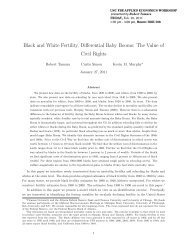

![15. RS 1.003 (RaJsu-yeni - nql?) RS 18.056 (RaJsu-yeni -5'[ ... ])](https://img.yumpu.com/51622603/1/189x260/15-rs-1003-rajsu-yeni-nql-rs-18056-rajsu-yeni-5-.jpg?quality=85)
